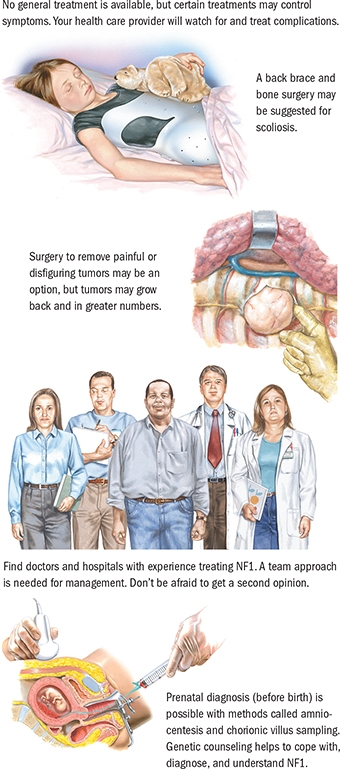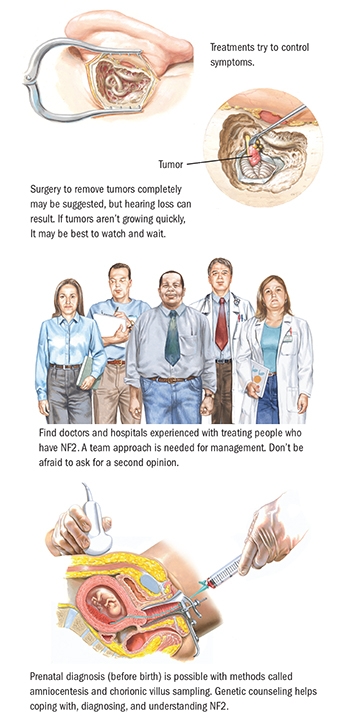Neurofibromatosis
If your child has multiple light brown birthmarks on his or her skin, this may be a sign of a condition called neurofibromatosis. Our team of specialists provide comprehensive care for children with this condition, including doctors, geneticists, psychologists and others. From diagnosis to medical care and even working with schools for any learning disabilities, our clinic has experts for both children and adults. Neurofibromatosis is a genetic mutation that can be an inherited condition, so we can see a family together, making complete care even easier for you and your child.
Need a Pediatric Doctor?
Our experienced pediatric doctors and specialists are ready to serve you and your family.
Neurofibromatosis is defined by tumors, called neurofibromas, that grow along nerves in the body or on or under the skin. Some children live almost unaffected by it, while others can be disabled by the condition. When the tumors grow, they can press on vital areas of the body, causing problems in the way the body functions. Although usually benign (non-cancerous), about three to five percent can become cancerous.
With more research being done every day, and support groups for children with neurofibromatosis, there's more hope every day and the expert care you need right here.
Treatment Options
Though neurofibromatosis does not have a cure, there are many ways to treat the various symptoms and health conditions that can arise from it. There are more advanced treatments being created as well, thanks to ongoing research into this condition.
Some children will not be affected at all, but for others, treatments can range from blood pressure medicine to surgery to remove tumors to pain medicine to devices such as cochlear implants (which is one of our specialties here at Helen DeVos Children's Hospital). It's rare for a tumor from neurofibromatosis to become cancerous, but if it does, our local advanced approaches to cancer treatment for children will seamlessly be included in your child's ongoing care.
Some children will also face some learning disabilities due to complications from tumors. If this is the case for your child, we also work with your child's school to help them overcome any challenges. It's all part of our approach to medicine for your child: providing comprehensive care.
Cochlear Implants
Sometimes children with neurofibromatosis can suffer hearing loss. We're experts in one of the most promising auditory devices for hearing loss today: cochlear implants.
Monitoring
Even if your child has no noticeable symptoms, it will be important to have regular checks for things like blood pressure changes, signs of early puberty, growth rates and skin conditions. This regular monitoring helps us take care of your child before symptoms become more serious.
Pain Medications
For some children with neurofibromatosis, medication for nerve pain, antidepressants or, rarely, epilepsy, are needed to help manage symptoms.
Surgery
When tumors grow or cause pain or other symptoms, surgery to remove them may be necessary.
Managing Neurofibromatosis Type 1

What Is It?
Neurofibromatosis (NF) is a genetic disorder that primarily affects growth of nerve cell tissue. It causes nerve tumors and skin and bone changes. Two types occur, type 1 (NF1) and type 2 (NF2). NF1 is also called von Recklinghausen’s disease. NF1 isn’t common, occurring in 1 of every 4000 people. It affects men and women equally and has been related to tumors of the brain, eye, and spinal cord and certain types of leukemia. There is no cure for it yet.
What Causes It?
NF1 is inherited, but more than half of people have no family history of NF1. It happens because of genetic mutations on chromosome 17. Each child born to a parent with NF1 has a 50% chance of getting it.
What Are the Symptoms?
Symptoms include small brown patches (café-au-lait spots), mostly on the chest, back, and tummy. Present from birth, they vary in size.
Several types of growths develop in and under the skin. They often appear in late childhood or early adolescence. They also vary from smaller than 1 inch to many inches. Larger ones can be disfiguring.
Other symptoms are freckling in body parts that normally don’t get sun (such as armpits and groin), learning problems (e.g., learning disabilities and low IQ, in about half of children), curved spine, bones that break easily, and high blood pressure. Growths in different places in the body cause symptoms.
Growths inside the head or on the spine can lead to seizures, loss of vision, and leg weakness (paralysis).

How Is It Diagnosed?
The health care provider will ask about family medical history and will do physical and eye examinations. Electroencephalography (EEG), which records brain waves, is done for seizures. Children have their IQ tested. A biopsy is done if cancer is possible. In a biopsy, a sample of the growth is removed and studied.
How Is It Treated?
No general treatment is available, but specific treatments may control symptoms. The health care provider will watch for and treat complications. Children with learning disabilities need special schooling. Physical and occupational therapy can help. Physical therapy benefits people with a curved spine and broken bones. Occupational therapy teaches people how to manage normal activities.
Surgery can help with bone abnormalities. Scoliosis may need surgery plus back braces. Painful or disfiguring tumors can be removed but may grow back. For rare cancerous tumors, surgery, radiation, or chemotherapy (anticancer drugs) can be used.
DOs & DON’Ts in Managing NF1:
- DO find doctors and hospitals that have experience with NF1.
- DO realize that NF1 diagnosis before birth is possible with methods called amniocentesis and chorionic villus sampling.
- DO call your health care provider if you see café-au-lait spots or freckles in your groin or armpit.
- DO call your health care provider if you have new nervous system problems (hearing loss, muscle weakness, or difficulty with walking or balance).
- DON’T be afraid to ask for a second opinion
- DON’T forget that NF1 is rare and will need a team approach for management.
For More Information
Contact the following sources:
- Neurofibromatosis, Inc. Tel: 800.942.6825
- National Neurofibromatosis Foundation, Inc. Tel: 800.323.7938
Managing Neurofibromatosis Type 2

What Is It?
Neurofibromatosis (NF) is a genetic disorder that primarily affects growth of nerve cell tissue. It causes nerve tumors and other abnormalities, such as skin changes and bone deformities. Two types occur, type 1 (NF1) and type 2 (NF2). NF2 is called bilateral acoustic neurofibromatosis. NF2 isn’t common, occurring in 1 of every 33,000 people. It affects men and women equally and has been related to tumors of the brain, eye, and spinal cord and certain types of leukemia. No cure exists as yet.
What Causes It?
What Is Neurofibromatosis Type 2? Neurofibromatosis (NF) is a genetic disorder that primarily affects growth of nerve cell tissue. It causes nerve tumors and other abnormalities, such as skin changes and bone deformities. Two types occur, type 1 (NF1) and type 2 (NF2). NF2 is called bilateral acoustic neurofibromatosis. NF2 isn’t common, occurring in 1 of every 33,000 people. It affects men and women equally and has been related to tumors of the brain, eye, and spinal cord and certain types of leukemia. No cure exists as yet. What Causes NF2? NF2 is inherited, but more than half of people have no family history of it. Genetic mutations occur on chromosome 22. Each child born to a parent with NF2 has a 50% chance of getting it.

What Are the Symptoms?
People with NF2 don’t tend to get the skin swellings and growths and bone problems that people with NF1 get. The main symptom is hearing loss. With NF2, other symptoms may occur because of growths in different places in the body. A growth inside the head or on the spine can lead to seizures, loss of vision, and leg weakness (paralysis).
How Is It Diagnosed?
The health care provider will ask about family medical history and will do physical and eye examinations. Magnetic resonance imaging (MRI) of the brain and spine is done to look for growths. They usually develop in the ear, but they can also grow inside the head or on the spinal cord.
Electroencephalography (EEG), which records brain waves, is done if seizures are present.
A biopsy is done if cancer is suspected. In a biopsy, a sample of the growth is removed and studied.
How Is It Treated?
Treatments try to control symptoms. The health care provider will watch for and treat complications. Children with learning disabilities need special schooling. Physical and occupational therapy can help. Physical therapy benefits people with a curved spine and broken bones. Occupational therapy teaches people how to manage normal activities.
Better diagnostic methods such as MRI can show tumors as small as a few millimeters in diameter, so treatment can begin earlier. Surgery to remove tumors completely is one option, but it may cause hearing loss. Other possibilities include partial removal of tumors, radiation, and, if tumors aren’t growing rapidly, the approach called watchful waiting.
DOs & DON’Ts in Managing NF2:
- DO find doctors and hospitals that have experience with NF2.
- DO remember that genetic testing is possible, but it can’t predict how severe the disease will be.
- DO understand that genetic counseling is good for coping with, diagnosing, and understanding NF2.
- DO realize that NF2 diagnosis before birth is possible with methods called amniocentesis and chorionic villus sampling.
- DO call your health care provider if you have new nervous system problems (hearing loss, muscle weakness, walking and balance difficulties).
- DON’T be afraid to ask for a second opinion.
- DON’T forget that NF2 is rare and patients will benefit from having a team approach for management.
For More Information
Contact the following sources:
- Neurofibromatosis, Inc. Tel: 800.942.6825
- National Neurofibromatosis Foundation, Inc. Tel: 800.323.7938
